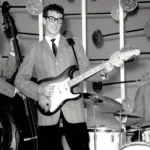
Buddy Holly and His Guitars
Buddy Holly was an influential singer-songwriter and guitarist who played a pivotal role in the development of rock ‘n’ roll music. Despite his tragically short career, Holly’s innovative guitar playing and unique vocal style left a lasting impression on the music world, inspiring generations of musicians to follow in his footsteps.
In this post, we’ll explore Holly’s life, his iconic guitars, and the equipment that helped shape his distinct sound.
Table of Contents
Early Life and Musical Beginnings
Charles Hardin Holley was born on September 7, 1936, in Lubbock, Texas. Growing up in a musical family, Holly was exposed to a variety of genres from a young age, including country, western, and gospel music. By the time he was a teenager, he had learned to play several instruments, including the piano, violin, and, most notably, the guitar.
Holly’s first guitar was a Harmony acoustic, which he received as a gift from his brother. He later upgraded to a Gibson J-45, a popular choice among country and folk musicians. ‘It was with this instrument that Holly formed his first band, Buddy and Bob, a duo with his high school friend Bob Montgomery. Together, they performed a blend of country and western music, incorporating elements of rhythm and blues.
In 1955, Holly and Montgomery attended a concert headlined by Elvis Presley, which would prove to be a transformative experience for the young musician. Inspired by Presley’s electrifying performance, Holly began to explore rock ‘n’ roll and its fusion of country, blues, and R&B sounds.
The Crickets and Holly’s Rise to Fame
In 1957, Holly formed the band The Crickets, featuring Jerry Allison on drums, Joe B. Mauldin on bass, and Niki Sullivan on rhythm guitar. The band’s first hit, “That’ll Be the Day,” was recorded at Norman Petty’s studio in Clovis, New Mexico.
Bands like The Shadows, The Beatles, Rolling Stones, Animals, and all the others did later the same. He was an innovator and inspired many guitarists like Jimi Hendrix, Eric Clapton, and Jimmy Page.
Buddy Holly and the Crickets made some of the most memorable records of the rock-and-roll era in Norman Petty’s off-the-beaten-track homemade studio in Clovis, New Mexico. Their first hit was, ‘That’ll be the day’ and many would follow.
Buddy Holly Guitars
Buddy Holly’s first recorded electric guitar was a Gibson Les Paul with a gold top.
Holly’s 1957 Fender Stratocaster, with its distinctive sunburst finish and maple neck, would become an extension of his persona. The Stratocaster’s design allowed for more versatile and expressive playing, which perfectly suited Holly’s innovative style. Its three single-coil pickups, synchronized tremolo system, and contoured body enabled Holly to experiment with a variety of tones and techniques, from clean fingerpicking to overdriven solos.
The most famous acoustic guitar Buddy owned was a Gibson J-45.
Holly’s Guitar Equipment and Amplifiers
For the amplification of the Fender Strat, he first made use of a small Ampeg amplifier, but later a Fender Twin-Amp, which was a present of Leo Fender.
When Buddy started playing bigger shows, he bought a Fender Bassman. At 50 watts, it was a powerful amplifier for its time. It was originally designed for the bass guitar, but guitarists quickly adopted it as well.
He didn’t use effects equipment on stage, because they did not exist in those days. He used in the studio the echo effect. Also, he frequently uses a capo on the fifth or first fret.
Tragic End and Lasting Legacy
Buddy Holly’s meteoric rise to fame was tragically cut short on February 3, 1959, when he, along with fellow musicians Ritchie Valens and J.P. “The Big Bopper” Richardson, died in a plane crash near Clear Lake, Iowa.
This tragic event would later be referred to as “The Day the Music Died,” a phrase coined by Don McLean in his song “American Pie.”
Despite the brevity of his career, Holly’s impact on the music world has been immense. His innovative guitar playing and pioneering use of studio techniques have influenced countless musicians, including The Beatles, The Rolling Stones, Eric Clapton, and Bruce Springsteen.
Holly’s distinctive guitar style combined elements of country, blues, and rock ‘n’ roll. Songs like “Peggy Sue,” “Rave On,” and “Not Fade Away” showcased his unique approach to rhythm guitar playing, which often involved the use of a capo to change keys and create a bright, jangly sound. Holly’s innovative use of double stops, a technique where two strings are played simultaneously, added depth and texture to his solos.
His Fender Stratocaster has become an iconic symbol of rock ‘n’ roll and inspired generations of guitarists to pick up the instrument.
